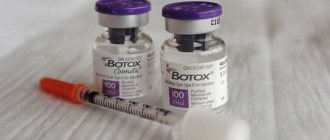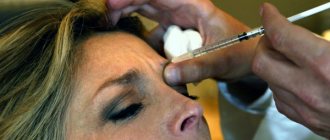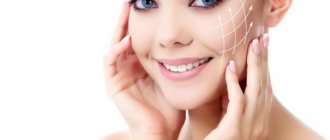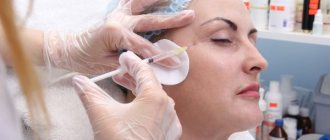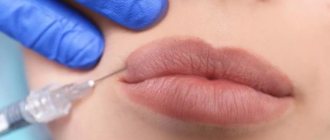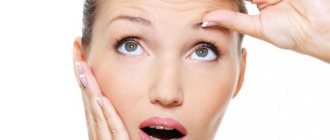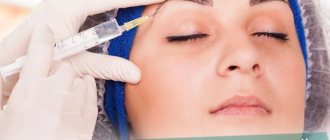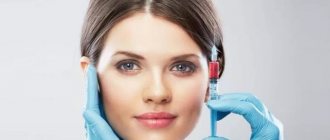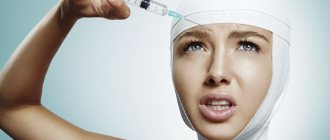Most women, when the first signs of aging appear, prefer to begin performing procedures that maintain youth. These are not necessarily manipulations that actually improve the quality of the skin. The most popular is Botox, which provides a quickly achievable but temporary change in appearance. You can achieve the desired results using different drugs. Botox Allergan is considered a classic option that does not lose prestige. The manufacturer became a pioneer in the field of application and gave impetus to the development of injection cosmetology.
Description of the drug
A drug called Botox, which gives its name to the injection procedure for temporary correction of wrinkles, is produced by the American company Allergan. The manufacturer works in the field of creating medicines, known since the 50s of the 20th century. As aesthetic medicine developed and the popularization of external perfection, the company developed the field of dermatology, released a line of weight loss products, and patented a substance based on botulinum toxin. It was Botox that brought Allergan worldwide fame and gave impetus to the development of injection aesthetics.
Currently, many analogues of the famous remedy have appeared. Developments in different countries can achieve similar results. Botox is considered a classic, authoritative drug. Many cosmetologists strive to work with him. Botox allows you to cope with small and large expression wrinkles, ptosis, and various cosmetic defects depending on the work of the muscles. The product is used for aesthetic and medical reasons.
Brief information about the manufacturer and product
The Allergan company, in whose laboratories today one of the types of Botox is produced, began its work back in the 50s of the last century. If initially the manufacturer specialized in the production of antihistamines and agents used in ophthalmology, then gradually its course was changed. Today the manufacturer produces the following products:
- Products to combat dermatological effects, including products for the care of the skin around the eyes.
- Medicines for weight correction and safe loss of extra pounds.
- Products used in urology, neurology, even surgery.
- The company is also known for its offers in aesthetic medicine.
Yet, the organization's primary focus is the improvement and distribution of injectable Botox. The substance was patented about 10 years ago and since then has been actively used to get rid of facial wrinkles, including very deep ones. By the way, this remedy can be used not only for aesthetic reasons, but also for some medical reasons, for example, to treat muscle spasms. But, in any case, control over its use must be carried out by an experienced specialist.
Composition of the substance
Botox is considered a reliable substance with a composition that has been tested many times in practice. The drug includes:
- botulinum toxin (900 kDa);
- albumin (500 mcg);
- NaCl (900 mcg).
The high molecular weight of the active substance limits unplanned diffusion into adjacent tissues. Botox is gentle and takes time to show results. The effectiveness of the drug is noticeable 2–7 days after injection.
The maximum severity of the results of injections lasts 1–2 months. Full development of strength occurs 2-3 weeks after the procedure. The result lasts 4–6 months. Complete elimination of the effect of the drug allows you to contact a cosmetologist for repeated procedures.
Botox analogues allow you to achieve results in a shorter time, the duration of action increases. Many manufacturers of botulinum toxins rely on improving the preparations: the ability to widely cover tissues, maintaining natural facial expressions, and the absence or minimization of protein additions.
Note! Cosmetologists practice different versions of botulinum toxins; the classic product remains the standard of the substance.
BOTOX®(BOTOX)
Rules for the preparation and storage of solution for injection
The preparation of the solution for injection and the collection of the solution into the syringe should be carried out on a work surface covered with a paper towel on a polyethylene lining, which makes it possible to quickly remove the spilled drug. Botox restoration is carried out only with 0.9% sodium chloride solution for injection. The injection solution is prepared by piercing the stopper with a sterile needle and introducing the required amount of solvent into the vial. If the solvent is not drawn into the vial under vacuum, the vial is destroyed. Before puncturing, the central part of the rubber stopper must be treated with alcohol. To pierce the cork, use a sterile 23-25 G needle.
Table 1. Drug concentrations obtained by dilution.
| Volume of solvent added (ml) | Dose received (IU per 0.1 ml) |
| 0.5 | 20 |
| 1 | 10 |
| 2 | 5 |
| 2.5 | 4 |
| 4 | 2.5 |
| 8 | 1.25 |
The solvent should be carefully introduced into the bottle (see table above), mixing the powder with the solvent with light rotational movements of the bottle. Vigorous shaking of the vial and the formation of foam can lead to denaturation of the drug. The finished solution is a clear, colorless or slightly yellowish liquid without foreign inclusions; slight opalescence may be observed.
Reconstituted Botox® can be stored in the refrigerator at a temperature of 2°-8°C for 24 hours. The prepared solution is administered using an insulin syringe with a fixed needle. Once reconstituted, the product must be used within 24 hours if stored correctly. Unused solution must be discarded.
The units of action of botulinum toxin in different preparations are not interchangeable. Recommended doses expressed in units of action for Botox differ from those for other botulinum toxin preparations.
No adequate dosing studies have been conducted in elderly patients. The same doses are used as in adults, but the use of the minimum effective dose is recommended.
Botox injections must be performed by a qualified physician who has undergone special training and received permission from the manufacturer. Injections can be performed on an outpatient basis in a treatment room.
The Botox dose and injection points are determined individually for each patient in accordance with the severity and location of muscle hyperactivity. In some cases, electromyography (EMG) is used to more accurately determine the localization of the pathological process.
Treatment of blepharospasm and hemifacial spasm
The Botox solution is injected with a needle measuring 27-30G/0.4-0.3 mm. For the treatment of bilateral blepharospasm
the drug is injected superficially into the upper eyelid into the medial and lateral sections of the orbicularis oculi muscle and into the lower eyelid into the lateral section of the orbicularis oculi muscle. Other points for injection: the pretarsal part of the orbicularis oculi muscle, the eyebrow area and the forehead area (if the spasm that occurs in it affects vision). To prevent the occurrence of ptosis, as a complication of the procedure, it is necessary to avoid administering the drug near the muscle that lifts the upper eyelid. To prevent diplopia, as a complication of the procedure, it is necessary to avoid injecting the drug into the medial part of the lower eyelid.
The initial dose is 1.25-2.5 units of the drug at each injection point. The total initial dose should not exceed 25 units on each side. The effect of the drug appears during the first three days after the procedure and reaches its maximum severity 1-2 weeks after it. The duration of the effect of the drug reaches 3 months, after which the procedure can be repeated.
If the effect of the initial treatment is regarded as insufficient, when the drug is re-administered, the dose can be increased by no more than twice. However, the introduction of more than 5 units of the drug at each injection point is not accompanied by a significant improvement in the clinical effect.
When treating blepharospasm, the total dose of Botox over 12 weeks should not exceed 100 units.
Treatment of patients with hemifacial spasm
carried out in the same way as with unilateral blepharospasm; if necessary, injections of the drug are also carried out into other affected facial muscles. The total dose of Botox for the treatment of hemifacial spasm should be the same as for blepharospasm.
Safety and effectiveness of Botox in the treatment of blepharospasm and hemifacial spasm
not demonstrated in
children under 12 years of age
Treatment of cervical dystonia (spasmodic torticollis)
The Botox solution is injected with a needle measuring 25-30G/0.5-0.3 mm.
In the treatment of spasmodic torticollis
the drug solution is injected into the most tense neck muscles in a dose of no more than 50 units at each point.
No more than 100 units of the drug is injected into the sternocleidomastoid muscle.
The total dose of the drug during the first procedure should not exceed 200 units.
When treating spastic torticollis, the drug is injected into the sternocleidomastoid muscle on the side opposite to rotation, and into the splenius muscle on the side of rotation.
In cases accompanied by shoulder elevation, the drug should be additionally injected into the trapezius muscle and the levator scapulae muscle on the affected side.
When tilting the head back, the drug is injected into the splenius and trapezius muscles on both sides.
When the head is tilted forward, the drug is injected into the sternocleidomastoid muscles on both sides.
With subsequent administration, the dose of the drug may be adjusted depending on the previous clinical result and observed side effects.
Clinical improvement appears within the first two weeks after injection of the drug. The most pronounced clinical effect is achieved approximately 6 weeks after injection. The duration of the clinical effect reaches an average of 12 weeks, after which, if necessary, treatment can be repeated. Intervals between therapy sessions of less than 10 weeks are not recommended.
In case of complex forms of torticollis or weak effect of treatment, EMG of the neck muscles should be performed to more accurately determine the localization of tense muscles.
Safety and effectiveness of Botox in the treatment of spasmodic torticollis in children under 12 years of age
not demonstrated.
Treatment of local muscle spasm in cerebral palsy
The Botox solution is injected with a needle measuring 23-26G/0.6-0.45 mm.
When treating spasticity and equinovarus deformity of the foot in children with cerebral palsy, the drug solution is injected into 2 points of each head of the gastrocnemius muscle (medial and lateral). In case of hemiplegia, the drug can be injected into the flexor muscles of the forearm, and when crossing the hips - additionally into the adductor muscles of the thigh. The total dose of the drug for one procedure is determined at the rate of 4-6 units/kg body weight and is distributed evenly between all muscles into which injections are performed. The total dose should not exceed 200 units.
Clinical improvement is evident in the first 7-14 days after injection. The drug is re-administered when the severity of the clinical effect is reduced by half, but not earlier than 3 months after the previous procedure. The dose of the drug is selected in such a way as to achieve at least a 6-month interval between procedures. Orthopedic correction, muscle stretching, and physical therapy can help improve the clinical effect of Botox injections.
Treatment of focal spasticity of the wrist and hand in stroke patients
The Botox solution is injected with a 25G, 27G, or 30G needle into the superficial muscles and a longer needle into the deep muscles.
To establish the localization of the muscles involved in the pathological process, EMG control or nerve fiber stimulation methods can be used. Injecting Botox into several points can help distribute it more evenly in the muscle, which is especially justified when injecting the drug into large muscles.
Selection of the exact dose of the drug and the number of injection points must be carried out individually in accordance with the size, number and location of the muscles involved in the pathological process, the severity of spasticity, the presence of local muscle weakness and the nature of the patient’s response to previous treatment.
Table 2. Dosages of Botox when injected into the muscles of the hand.
| Muscle | Total dose; Number of injection points |
| Flexor digitorum profundus | 15-50 units; 1-2 points |
| Flexor digitorum superficialis | 15-50 units; 1-2 points |
| Flexor carpi radialis | 15-60 units; 1-2 points |
| Flexor carpi ulnaris | 10-50 units; 1-2 points |
| Adductor pollicis muscle | 20 units; 1-2 points |
| Flexor pollicis longus | 20 units; 1-2 points |
Positive changes in muscle tone were noted within 2 weeks after injection, the maximum clinical effect was observed, as a rule, no later than 4-6 weeks.
In cases where the attending physician considers it necessary to re-administer the drug, it can be done after the effect of the drug on muscle tone has decreased. The interval between injections should be at least 12 weeks. Changing the degree and nature of muscle spasticity before re-introducing the drug may require adjusting the Botox dose and identifying new injection points. The minimum effective dose must be used.
In patients with focal spasticity, Botox® is used in combination with a standard treatment regimen. The drug is not intended to be used as a replacement for these treatments.
Treatment of paralytic strabismus (strabismus)
The Botox solution is injected with a 27G needle.
Botox® is injected into the muscles of the eyeball under EMG control. To prepare the eye for a Botox injection, it is recommended to instill several drops of a local anesthetic and decongestant into the conjunctival sac a few minutes before the procedure.
For minor deviations of the eyeball, minimal doses of the drug are used; when treating more pronounced deviations, the dose is increased.
Initial doses:
- when injected into the muscles that carry out vertical movements of the eyeball (superior and inferior rectus muscles) and with horizontal strabismus, less than 20 prismatic diopters: from 1.25 to 2.5 units for any muscle;
— for horizontal strabismus from 20 to 50 prismatic diopters: from 2.5 to 5 units for any muscle;
— with paralysis of the abducens nerve (VI nerve) that persists for 1 month or more: from 1.25 to 2.5 units in the medial rectus muscle.
The initial effect is observed 1-2 days after the procedure, increases during the first week, persists for 2-6 weeks and gradually decreases over the same time period. Rare cases of persistence of the effect for more than 6 months have been described.
Approximately half of the patients after the first injection of the drug require repeated administration due to an inadequate clinical response of the muscles to the first procedure or due to mechanical factors: significant deviation or limitation of the mobility of the eyeballs, as well as the inability to stabilize the position of the eyes due to the motor component of binocular fusion (fusion) . It is recommended to examine patients 7-14 days after each injection to assess the effect of the procedure. In patients with incomplete relaxation of the target muscle during subsequent administration, the dose of the drug can be doubled.
Repeated administration of the drug should be carried out only after the clinical effect from the previous procedure has decreased, which is expressed in a stable restoration of the function of the injected and adjacent muscles.
The maximum recommended dose for a single injection into any muscle for the treatment of strabismus is 25 units.
Correction of facial wrinkles
It is not recommended to use Botox® for the correction of vertical facial wrinkles between the eyebrows in patients
under 18 and over 65 years of age
.
Botox solution (100 units/2.5 ml) is injected with a 30G needle.
4 units are injected into 5 injection points: into the musculus corrugator - 2 points on each side, into the musculus procerus - 1 point. The total dose is 20 units.
Before administering the injection, it is necessary to press the thumb and forefinger firmly against the skin below the edge of the orbit to prevent the drug from spreading below this level. When performing an injection, the needle should be directed upward and medially. To reduce the risk of developing ptosis, it is necessary to avoid administering the drug near the levator palpebrae superioris muscle, especially in patients with well-defined levator palpebrae superioris muscle. When injecting the drug into the corrugator musculus, the injection must be made into the central part of the muscle, retreating at least 1 cm above the arch of the eyebrow.
Smoothing of vertical facial wrinkles between the eyebrows occurs, as a rule, within a week after the procedure. The effect lasts up to 4 months.
The interval between procedures should be at least 3 months. If there is no effect from the administration of the drug or a decrease in its severity after repeated injections, other treatment methods should be recommended.
For all indications for use
If the first procedure is ineffective, i.e. In the absence of significant clinical improvement compared to the initial state, 1 month after administration of the drug, it is necessary:
- clinical confirmation of the effect of the toxin on the injected muscle(s), which may include an EMG study performed by an experienced specialist in a specialized department;
- analysis of the reasons for the ineffectiveness of the procedure, for example, inadequate selection of injection points, insufficient dose, incorrect injection technique, signs of fixed contracture, weakness of antagonist muscles, formation of toxin-neutralizing antibodies;
— re-evaluation of the appropriateness of treatment with botulinum toxin type A;
- in the absence of any undesirable effects associated with the first administration of the drug, the following conditions must be met during the repeated procedure: dose adjustment taking into account the analysis of the reasons for the ineffectiveness of the previous procedure; EMG control; the interval between procedures should be at least 3 months.
If there is no effect from the administration of the drug or a decrease in its severity after repeated injections, other treatment methods should be recommended.
Indications for use
Botox is valuable in medicine and cosmetology due to its ability to temporarily immobilize target muscles. The drug relieves muscle hypertonicity, relaxing spasmodic areas, and provides a pronounced lifting effect. Traditionally, Botox is used to solve problems:
- muscle spasm (torticollis, cerebral palsy, consequences of strokes, dystonia);
- ophthalmological disorders (strabismus, blepharospasm);
- increased sweating (hyperhidrosis);
- cosmetic defects (wrinkles, ptosis, asymmetry).
The drug can be used for medicinal purposes in adult patients and children over 2 years of age. Cosmetic interventions with botulinum toxins are available to those over 18 years of age. Doctors recommend anti-aging correction from the age of 25, taking into account the individual characteristics of age-related changes. Botulinum toxins are popular among women and men aged 30–55 years.
Indications for use of Botox
Indications for the use of Botox vary for the field of cosmetology and the treatment of various diseases.
In cosmetology, the product is used for:
- The appearance of permanent wrinkles due to frequent involuntary or spastic contractions of the muscles of the face, neck, and head. Most often, Botox is used to eliminate wrinkles on the bridge of the nose, forehead and eyebrows, “crow’s feet” near the eyes, as well as “bunny folds” on the nose;
- Treatment and healing of deep wounds that leave scars;
- Various cosmetic defects of large skeletal muscles - protruding muscle fibers, too prominent or massive-looking muscles.
Most often, Botox injections are used in cosmetology specifically to combat wrinkles - on the forehead, in the eye area, nasolabial folds, on the neck and décolleté.
Wrinkles caused by aging, dry skin, and loss of elasticity due to various pathologies are not an indication for the use of Botox. In these cases, various fillers (in particular, hyaluronic acid) are used to restore the normal condition of the skin and subcutaneous tissue. Only a doctor who understands anatomy and understands all the nuances of the interaction of agonist and antagonist muscles with other facial tissues can find out why certain wrinkles arose.
In therapeutic practice, indications for the use of Botox from Allergan are:
- Tonic blepharospasm - closure of the eyelid due to constant tension of the pretarsal part of the pectoral muscle of the eye;
- Various facial muscle spasms (hemifacial spasm);
- Cervical dystonia - spasms of the shoulders and neck, leading to changes in posture, constantly raised shoulders, tilting the head to the side (torticollis);
- Chronic migraine;
- Urinary incontinence in adults caused by neurogenic overactivity of the bladder detrusor;
- “Equine foot” syndrome in children with cerebral palsy;
- Spasm of the wrist and hand in patients who have had a stroke.
In all these cases, botulinum therapy can be classified as symptomatic treatment, since it affects only the consequence of the pathology, but not its causes.
Efficacy of the drug
Botox is often used to solve cosmetic problems. The greatest effectiveness is noticeable when eliminating age-related defects of the upper third of the face: wrinkles, folds of the forehead, eyes. For using the drug in “difficult” areas of the lower third: lips, nasolabial folds, chin, the result depends on the skill of the cosmetologist.
Botox is used to eliminate excessive sweating (hyperhidrosis). Injections of the substance are performed in problem areas: armpits, palms, feet. Immobilization of muscles by the drug affects the functioning of the glands. The problem of increased sweating is eliminated for 6–9 months.
To treat spastic conditions, individual areas of the muscles are immobilized. By fixing the tissue, the existing defect is minimized. The condition is alleviated and the problem is corrected: the motor activity of the limbs stabilizes, speech and viewing angle change.
Botox and depression: Allergan doesn't give up
Allergan reported results from a phase II clinical trial of Botox (onabotulinumtoxinA) for the treatment of major depressive disorder, also known as clinical depression. And although the results were mixed, the Irish pharmaceutical company hopes to continue research by launching phase III.
The test scheme is as follows. 258 female patients with moderate-to-severe clinical depression (minimum Hamilton Depression Rating Scale [HDRS] score 18 and Clinical Global Rating Scale score 4) were randomized into three groups. The first received 30 units of Botox by injection into the eyebrow fold, the second received 50, and the third received a placebo.
The differences between the first and control groups on the Montgomery-Osberg Depression Rating Scale (MADRS) were: –4.2 points on the 3rd week after therapy, –3.7 points on the 6th week, –3.6 points on the 9th week. y. Thus, the primary endpoint was recorded as a statistically significant difference selected at week 6. In addition, two secondary endpoints were achieved.
The second group did not demonstrate statistically significant effectiveness compared to placebo.
"Mosmedpreparaty"
The mixed results suggest that Botox trials need to be scaled up to evaluate its therapeutic effects in a much larger sample of patients.
The use of botulinum toxin as an antidepressant is based on the facial feedback hypothesis put forward in the 19th century. Contraction of the facial muscles is believed to send a message to the emotional centers of the brain. A smile can strengthen and support a feeling of well-being, while a frown, on the contrary, leads to the experience of fear, anger and sadness. Interrupting proprioceptive feedback between the face and the emotional brain will reduce negative mood scores.
Botox is the jewel in Allergan's crown. It, being the top drug in its portfolio, earned money in 2014, 2015 and 2021. respectively 2.23; $2.49 and $2.79 billion. The product is approved for a dozen different indications - aesthetic and therapeutic. Adding clinical depression to this spectrum would not only increase sales of Botox, but would also give doctors and patients additional choice in managing the disease, since any given antidepressant is effective in only a third of patients.
Purchasing botulinum toxin
The system of selling drugs containing botulinum toxin through a limited number of pharmacies, which requires presentation of a license to work with the substance, helps to stop the spread of counterfeit products. By purchasing Botox in this way, cosmetologists remain confident in the quality of the substance. There are many offers on the Internet for the sale of botulinum toxins. You will be able to find any product at an attractive price without guaranteeing the quality of the product. This is dangerous for doctors and patients
The cost of a tube of Botox Allergan 100 units can be purchased for 10–13 thousand rubles.
Important point! The substance is in the state of lyophilisate (dry powder). The granules need to be dissolved. The cosmetologist mixes the dry substance with saline solution in a certain proportion. The doctor uses a syringe to inject liquid through a closed stopper. The collection of the substance by a cosmetologist is identical.
Preparing for injections
The Botox injection procedure does not require complex preparation from the patient. It is important to pay close attention to your well-being. Any ailments are unacceptable. The cosmetologist assesses the general condition of the patient and the possible presence of contraindications.
Before the procedure, they strive to maintain the cleanliness and integrity of the skin. There must be no inflammation or irritation. The skin should not be damaged or thinned by other manipulations (plastic surgery, resurfacing, peeling).
Before injections you should not:
- drink alcohol;
- take antibiotics, anticoagulants;
- perform actions that increase blood circulation, provoking a rush to the intended work areas (physical activity, massage, active bending down).
It is recommended to adhere to restrictions of 1-2 days before the procedure. It is advisable to increase this period to 1–2 weeks. It is not recommended to drink a lot of liquid on the day of injections. It is better to come to the procedure without makeup (with a minimum of cosmetics on your face). Before the session, it is not advisable to smoke or participate in stressful situations.
Carrying out the procedure
The meeting between the doctor and the patient begins with a consultation. The cosmetologist asks many questions that influence the decision on the possibility of injections. The patient’s health status, lifestyle, and external appearance are important.
The doctor compares the information received with the client’s expectations, selects a course of action, calculates the dosage, and prescribes the procedure.
On the day of injection, the patient sits in a cosmetology chair. The procedure takes place with the body in an upright position. The skin in the affected areas is cleaned and an antiseptic is used. No significant anesthesia is provided. It is enough to use the ice cooling method. It is possible to use a local anesthetic before the procedure.
The cosmetologist examines the prepared skin and makes markings. Injections are made at the planned points. The doctor works with a solution prepared in front of the patient. This guarantees the patient the freshness of the drug. Additionally, it is advisable to request a tube for examination. The packaging must be undamaged and within the expiration date.
The doctor works with a thin insulin needle. The punctures are accurate and the impact does not cause pain to the patient. Depending on the chosen administration regimen, the doctor injects into the muscle or subcutaneously. The competence of a cosmetologist is important. Insufficient experience of the doctor often leads to undesirable consequences from the procedure.
To obtain the intended result, it is important to choose the correct dosage of the drug. The number of required units of botulinum toxin is selected individually. There are generally accepted maximum possible quantitative limits. The smallest dose needed for eyebrow lifting and nose correction is 5 units. To affect the area of the chin and lips - 6 units. For essential areas the following restrictions apply:
- crow's feet - 15;
- forehead - 20;
- between the eyebrows - 25;
- neck - 50;
- oval lift - 60.
After performing the injections, the doctor monitors the patient's condition. The state of health is monitored and the external picture is monitored. Minor ailments (headache, weakness), swelling and bruising are possible. There may be a feeling of heaviness and pain at the injection sites. After 30 minutes, the condition stabilizes, the doctor gives recommendations and releases the patient.
The procedure lasts about 30 minutes. At the end of the session, the patient can go to work and do everyday activities. External traces of injections are minimal and do not affect the quality of life.
Important! After 2 weeks, the doctor prescribes a follow-up examination after the procedure. Achievements are assessed. If the result is insufficient, correction may be made.
Instructions for use: preparation for the procedure and procedure for injections
As a rule, Botox injections can be performed at the first visit to a cosmetologist. It is first necessary to diagnose the causes of certain wrinkles, check the interaction of antagonist muscles, develop a regimen for administering the drug, and plan its consumption by the doctor.
Before injecting the drug, the cosmetologist must understand the reasons for the appearance of certain wrinkles in the patient and have a good understanding of exactly where botulinum toxin should be injected and to what depth.
On a note
In some cases, disagreements may arise between the patient and the doctor. For example, the patient wants the number of injections and the amount of the administered drug to be minimal, and injections should be given only to those muscles that cause wrinkles. But a specialist who is well versed in facial anatomy understands that inactivation of only these muscles can lead to even more severe cosmetic defects due to the activity of antagonists - this is how “Mephistopheles eyebrows”, some variants of ptosis, and a “sad face” appear. To avoid such situations, you should contact a highly qualified specialist for botulinum therapy, and then completely rely on his professionalism.
After the initial consultation, the doctor informs the patient about possible side effects and gives him informed consent to use Botox to sign.
It is also useful to read: Is it possible to inject Botox during menstruation?
Directly during the injections, the patient is seated in a chair in which it is convenient to adjust the tilt and height of the head.
The doctor reconstructs the Botox solution from the powder, taking into account the specifics of the specific procedure. Each bottle of Botox contains 100 units of the active substance, which are normally diluted in the bottle itself with pure saline solution (sodium chloride solution) with a volume of 2.5 ml to obtain a final concentration of the drug of 4 units per 0.1 cm3. However, in some cases, to eliminate wrinkles or to treat certain pathologies, dilutions may be different, and the value in each specific case is determined only by a doctor.
The photo below shows a 100 unit bottle of Botox (Allergan):
Botox (Allergan), 100 units
On a note
The form, on one side of which is informed consent for the use of the drug Botox, on the other side usually has a form describing the use of the drug, with a map of injection points, as well as a description of the patient’s condition before the procedure and a listing of standard dilutions - 1.25 IU / 0.1 ml, 2.5 units/0.1 ml, 4 units/0.1 ml, 5 units/0.1 ml, 10 units/0.1 ml. The doctor emphasizes here what he will use, or enters a unique meaning. It also indicates how many units of the drug will be administered at each point.
Then:
- The doctor draws the drug solution into the syringe;
- The face is treated with frozen gel or a special anesthetic for mild local anesthesia;
- The doctor begins to inject the drug into the muscles. The site of each injection of the product is lightly pressed with a finger. The drug may be injected into some muscles several times during the procedure. The amount of product is determined by the strength of muscle contraction, dilution of the drug, the severity of wrinkles and some other factors. On average, for example, 5 units of Botox are injected into the corrugator brow muscle per injection, and 17-20 units into the depressor brow muscle - 17-20 units.
At the end of the procedure, the skin is wiped with a damp cotton swab, and the doctor monitors the patient’s condition. If there are no signs of an allergic reaction, the procedure is completed. Its duration is usually 10-40 minutes.
After the procedure, barely noticeable red dots remain on the skin at the injection sites, which disappear the very next day.
For 3-4 days after botulinum toxin injections, it is extremely important to carefully monitor your condition, and if there are signs of generalized side effects, consult a doctor.
Rehabilitation period
To obtain the expected effect, not only the skills of a cosmetologist are important. Compliance with the restrictions of the recovery period will help minimize the risk of undesirable consequences and facilitate the administration of the substance. After injections it is prohibited:
- 4–6 hours lie down, bend forward, down;
- touch, rub, knead the skin in the puncture area;
- physically strain;
- sleep on your stomach;
- take certain medications, alcohol;
- warm up, steam the skin (do a massage, visit a bathhouse, sauna, take a hot shower, be exposed to ultraviolet radiation).
It is enough to follow the restrictions until you get a full result. After 2 weeks, it is permissible to gradually abandon the prohibitions. It’s good if you can comply with the restrictions for up to a month.
After injections, it is recommended to refrain from performing cosmetic interventions (masks, peelings, surgeries). It is not advisable to become pregnant 2–4 weeks after the manipulations.
Appearance after the procedure changes slightly. Possible swelling and bruising. To prevent the situation from worsening, it is not recommended to drink excessive amounts of liquid.
No special skin care is required. Careful cleansing is a must. Avoid overexposure to injection areas. It is advisable to temporarily give up cosmetics (limit the amount).
The effect of Botox injections lasts 4–6 months. The result disappears gradually. The procedure can be repeated in agreement with the cosmetologist after complete regression. The next intervention is not performed earlier than 2 months later.
Possible side effects from therapy
Unfortunately, even with proper use of high-quality Allergan Botox, side effects occur. They can be very different and usually depend on the place of administration of the drug and the purpose of its use.
- Treatment of spasms. In 10% of cases, drooping of the lower eyelid, weakness of muscle fibers, pain in the puncture area, infection of the punctures, and problems with swallowing food were noted. Much less common are dry mucous membranes, indigestion, fever, and general weakness. Sometimes specific manifestations are observed: corneal defects, swelling, insomnia, shortness of breath, depression.
- Treatment of hyperhidrosis. In 10 cases out of 100, there is pain in the puncture area. Much less common are headaches, increased sweating in other areas of the skin, bruises, and muscle weakness.
- Elimination of wrinkles between eyebrows. In less than 1% of cases, asymmetry, muscle weakness, dry mouth, tissue infection, and convulsions may occur.
Negative phenomena associated with muscle function gradually disappear on their own, after about 2-3 months. This is due to the fact that Botox is gradually eliminated from the body. In less than 1% of cases, people become addicted to the drug. It manifests itself in the production of antibodies, which reduces the effectiveness of the approach. To obtain the desired result, dosages have to be increased, but at the same time the likelihood of developing side effects increases.
Cost of injections
Botox injections must be performed by an experienced doctor who has the appropriate license to work with botulinum toxin.
It is recommended to seek the services of cosmetologists working in well-known clinics with a good reputation. The cost of Botox-based procedures is 300–400 rubles. per unit of drug.
Nowadays, a home system for receiving cosmetologists is common. Such specialists rarely have a license to administer botulinum toxin injections. At home, it is difficult to achieve the required sterility. It is necessary to take these nuances into account when choosing a performer.
Features of the choice of drugs for injection facial rejuvenation, what are they?
Women who decide to use Botox for the face should know that botulinum toxin is a deadly poison that causes spasm of the respiratory tract, which results in death. In cosmetology, it is used to smooth out wrinkles in certain proportions and in combination with other substances that neutralize its toxic properties.
It is not always possible to completely neutralize the toxicity of Botox. This leads to the following consequences occurring after using the product in cosmetology:
- bruising or redness at the injection site;
- paralysis of facial muscles;
- swelling;
- deformation of the lip line;
- headache;
- change in the line of the eyebrows, or rather, its lowering;
- allergy.
Based on Botox, various drugs are made, differing in the additional components in the composition. You need to choose carefully, studying its properties, composition, side effects. If you use the wrong one, the woman will not get the effect she expected, but unpredictable consequences.
An experienced cosmetologist will help you choose the appropriate drug for “beauty injections”, based not only on general information, but on the individual characteristics of the patient.
How to speed up the elimination of the drug
If you receive negative consequences, it will not be possible to immediately remove the drug from the body. Botulinum toxin remains in the tissues for a specified amount of time. Additional actions will weaken the effect of the drug, softening the effect. In unforeseen situations, doctors recommend:
- performing massage;
- a course of physiotherapeutic procedures;
- carrying out drug treatment.
These effects help reduce muscle fixation. The effect of botulinum toxin gradually decreases, negative manifestations are minimized. It is recommended to carry out “treatment” under the supervision of a doctor. Wrong actions can cause harm and enhance the effect.
Note! At home, heat is used to remove toxins. A hot shower, bath, sauna in combination with self-massage can quickly eliminate unwanted consequences.
Advantages and disadvantages
The clear advantage of Allergan Botox is its classic composition and its action, which has been tested many times. Cosmetologists and patients trust the manufacturer and the product. No surprises are expected with Botox. The drug rarely causes side effects.
The disadvantage of Botox is its short action. Drugs have been created with longer retention of results. You will also have to wait longer to receive the first changes than with other means.
The effect of the classic remedy is rough. There are softer analogues.
Contraindications
You will have to reschedule Botox injections or refuse the procedure if:
- acute forms of diseases (chronic, systemic);
- failure of neuromuscular functions;
- pregnancy, breastfeeding;
- blood diseases, endocrine disorders;
- hypersensitivity to the components of the injection substance.
The decision to carry out manipulations is made by the doctor. The patient is obliged to answer the cosmetologist's questions honestly, without concealing information about his or her health status. Cosmetic procedures are not performed on minors. Interventions are not recommended for persons with neurological disorders. It is advisable to postpone the procedure on menstrual days.
Side effects
The possibility of side effects depends on the skill of the doctor, compliance with restrictions during preparation and recovery. An inexperienced cosmetologist does not always perform injections correctly and makes mistakes in calculating the dosage. The fact that the drug did not rise or did not take may be the fault of the patient who does not comply with the prescription. There may be:
- Difficulties with well-being (gastrointestinal upset, problems with breathing, swallowing);
- swelling, pain, numbness at the injection sites;
- asymmetry, excessive tissue coverage.
When injections are administered correctly and recommendations are followed, side effects rarely occur. Possible minor headache and weakness. The symptoms go away on their own. Cosmetologists warn about the possibility of individual unforeseen reactions of the body.
Composition of the drug and its mechanism of action
The Allergan company produces several types of Botox preparations intended for different purposes. Specifically in cosmetology, Botox Cosmetic is used to combat wrinkles. Its active ingredient is onabotulinumtoxinA, which is a complex of group A botulinum toxin and several associated proteins. When introduced into a muscle fiber, this substance is concentrated at the periphery of muscle cells and penetrates the neurons innervating the cell. Here, botulinum toxin inactivates proteins responsible for the rupture of synaptic vesicles with acetylcholine. Without the activity of these proteins, acetylcholine, the main neurotransmitter, is not released from the neuron and does not stimulate muscle contraction even when the nerve cell receives a “command” impulse.
Simply put, if Botox is injected into a specific muscle, then this muscle loses tone and relaxes, and then for a certain period of time does not contract at all - neither under the influence of reflex impulses, nor even when a person consciously attempts to tense it.
The result of Botox injections in a man is that deep wrinkles on his forehead are almost completely smoothed out.
The main result of this action is the disappearance of wrinkles that arise due to constant voluntary or involuntary contraction of those facial muscles into which the drug is injected. The muscles relax, stop tightening the skin, as a result of which it smoothes out.
The obvious and most harmless side effect of Botox is the inability to contract the “punctured” muscles. This affects facial expressions: various vivid emotions in a person may appear somewhat unnaturally, since the usual changes on the face with such emotions do not occur.
On a note
For example, after Botox is injected into the proud muscle (Musculus procerus) between the eyebrows, the expression of emotion during aggression or dissatisfaction is lost - a person simply cannot bring his eyebrows together.
Similarly, when smiling, the muscles between the nose and lips (the drug is injected into them to eliminate nasolabial folds), as well as on the sides of the eyes, may not be used.
However, since all muscles are not completely treated during Botox injections, a person’s ability to facially express emotions is preserved. And the more professionally the procedures and preparation for them are carried out, the less noticeable will be the unwanted changes in facial expressions with the obvious smoothing of wrinkles.
On average, a clear effect from a particular procedure is observed 3-4 days after injections. In some cases, it can be faster and appear the very next day, and sometimes, on the contrary, the required result is obtained only after 10-14 days.
Review:
“The doctor tried to dissuade me from Botox for a long time, saying that my one wrinkle between the eyebrows was completely invisible and it was better to carry out biorevitalization. But, to be honest, I was already tired of these endless masks, scrubs, and insisted on Botox. And I didn’t regret it. The whole procedure cost 3,200 rubles, the time was 2-3 minutes, plus there was 20 minutes of preparation before it: you wince, the doctor looks at the wrinkles, at the skin, and decides where to inject. Then you sign the consent and they inject you. After 6 days, my wrinkle disappeared. Fully! It was as if she hadn’t even existed 5 years before. And there is no inconvenience, no discomfort, no headache. Either on the official website, or somewhere else, I read about various horrors such as jumping eyebrows, drooping eyelids. I didn't have anything like that. It’s been 6 months now and Botox is slowly wearing off. If I’m angry, a wrinkle appears, but normally it’s not there yet. So it will be necessary to repeat it soon, but it’s worth it...”
Katya, St. Petersburg
The effect of Botox is limited in time to an average of 90-110 days (3-4 months). Research shows that during this period, almost all deactivated nerve endings are replaced by new ones as a result of the process of sprouting. At the same time, new processes begin to grow from the nerve cell, connecting to the muscle fiber. This process starts immediately after botulinum toxin enters the cell (that is, immediately when Botox begins to act), but is not fast, and leads to suppression of the effect of botulinum toxin only after 3-4 months.
On a note
Botox from the Allergan company, produced for medical purposes, acts in a similar way, but it is injected into the muscles for various syndromes accompanied by muscle spasms - blepharospasm, strabismus, spasmodic torticollis, hemifacial spasm. Here Botox also provides relaxation of the muscles leading to spasm. The drug is also used in urology to reduce the activity of the bladder detrusor, to treat skin hyperhidrosis (increased sweating) and to eliminate spasms of individual muscles in children with cerebral palsy.
There is virtually no difference in effectiveness and safety between Botox and other botulinum toxin preparations. Its fundamental difference from its analogues is that its active complex is the heaviest - the mass of onabotulinumtoxin is approximately 900 kDa, while, for example, the abobotulinumtoxin molecule in Dysport weighs 500-800 kDa, and the pure botulinum toxin molecule in Xeomin weighs only 150 kYes.
Today there are many botulinum toxin preparations on the market with different names. The most commonly used in cosmetology are Botox, Dysport and Xeomin.
It is believed that such a large molecular weight and the presence of auxiliary proteins in Botox may affect its distribution in tissues after injection and the body’s development of an immune response to it. Xeomin is believed to diffuse into the muscles more quickly and spread over a larger area than Botox, making the distribution of Botox more controlled and less likely to trap and deactivate muscles that were not intended to be treated. However, it is in response to Botox that the body should, according to theory, produce more antibodies, since it contains more specific proteins. This would lead, first of all, to a shorter duration of action of Botox, as well as to a higher frequency of allergies to it than to analogue drugs.
It is also useful to read: Botox injections into nasolabial folds
According to the results of the studies, it was not possible to detect a statistically significant difference in the frequency of side effects and the rate of distribution in tissues between Botox and its analogues. Today, the differences in dosages of agents and, accordingly, the order of their dilution, as well as in price, remain practically significant.
Opinion of cosmetologists
Doctors speak positively about American botulinum toxin. The classic drug is used by beginners and experienced doctors. There is a lot of information about the substance. He is easy to work with. The drug allows cosmetologists to cope with complex tasks. Patients have more confidence in a known substance.
https://pf-k.ru/
Cosmetologists trust classic botulinum toxin, get positive results, and recommend the substance to patients.
Compared to strong analogues, Botox is rated higher.
Many are betting on the drug's popularity. Patients trust the classic version of botulinum toxin more.
Patient reviews
Botox injections have been tried by many patients. Most cosmetologists prefer to begin introducing clients to botulinum toxin with this drug. Patients trust the brand, the well-known name, and are guided by numerous reviews about the substance. Recently, there have been patient complaints about a decrease in the effectiveness of the product.
https://plastic-surgeon.ru/forum/showthread.php?t=11655&page=6
Many people complain that Botox has gotten worse over time. The muscle blockade does not last for the stated amount of time.
Botox is considered a powerful remedy with a good reputation.
Some people are dissatisfied with Botox's ability to strongly lock muscles. It is not possible to obtain live facial expressions using botulinum toxin.
